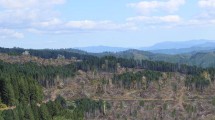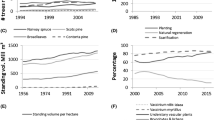Abstract
International forest policies have recently increased the focus on involvement of local communities in forest monitoring and management as a strategy to improve biodiversity conservation efforts and local livelihood in developing countries. However, little is known about feasible methods, costs and accuracy of participatory monitoring schemes in developing countries. This paper examines the costs, accuracy and local reproducibility of three simple cost–effective methods for monitoring forest disturbance by local participants: (1) 20-trees method, (2) Bitterlich gauge method and (3) Disturbance Checklist transect. Using one of these methods the costs of monitoring forest habitats are only between US$ 0.04 and 0.12 ha−1 annually, depending on the methods used, this is significantly cheaper than the costs of traditional scientific methods for biodiversity monitoring. Results indicate that local community members without former scientific training can collect accurate data on habitat loss and forest disturbance after only a few days of introduction to the methods, and thereby contribute with valuable information for natural resource management. The strengths and weaknesses of monitoring done, respectively, by local community members and educated biologists, respectfully, are discussed. It is suggested that these approaches should be seen as supplements to each other rather than substitutes. Finally, it is argued that monitoring schemes in developing countries can be sustained after donor funds have ceased only if the local communities play a central role and clear financially and/or socially incentives for members of the local community are incorporated.



Similar content being viewed by others
References
Andrianadrasana HT, Ranndriamahefasoa J, Durbin J, Lewis RE, Ratsimbazafy JH (2005) Participatory ecological monitoring of the Alaotra wetlands in Madagascar. Biodivers Conserv 14:2757–2774
Balaguru B, Britto SJ, Nagamurugan N, Natarajan D, Soosairaj S (2006) Identifying conservation priority zones for effective management of tropical forests in Eastern Ghats of India. Biodivers Conserv 15:1529–1543
Balmford A, Bennun L, ten Brink B, Cooper D, Côté IM, Crane P, Dobson A, Dudley N, Dutton I, Green RE, Gregory RD, Harrison J, Kennedy ET, Kremen C, Willianms NL, Lovejoy TE, Mace G, May R, Mayaux P, Morling P, Phillips J, Redford K, Ricketts TH, Rodriguez JP, Sanjayan M, Schei PJ, van Jaarsveld AS, Walther BA (2005) The Convention on Biological Diversity’s 2010 target. Science 307:212–213
Becker CD, Agreda A, Astudillo E, Costantino M, Torres P (2005) Community-based monitoring of fog capture and biodiversity at Loma Alta, Ecuador enhance social capital and institutional cooperation. Biodivers Conserv 14:2695–2707
Birdlife (2005) Instituting a standardized sustainable biodiversity monitoring system in the Eastern Arc Mountains and Coastal forests of Kenya and Tanzania. Proceedings of a stakeholder consultation workshop on monitoring biodiversity in the Eastern Arc and Coastal forests hotspot. 30 May to 1 June, Dar es Salaam, Tanzania
Bleher B, Uster D, Bergsdorf T (2006) Assesment of threat status and management effectiveness in Kakamega Forest, Kenya. Biodivers Conserv 15:1159–1177
Brandon A, Spyreas G, Molano-Flores B, Carroll C, Ellis J (2003) Can volunteers provide reliable data for forest vegetation surveys? Nat Areas J 23:254–262
Brearley FQ, Prajadinata S, Kidd PS, Proctor J, Suriantana (2004) Structure and floristics of an old secondary rain forest in Central Kalimantan, Indonesia, and a comparison with adjacent primary forest. For Ecol Manage 195:385–397
CBD (1992) The Convention on biological diversity. http://www.biodiv.org/convention/articles.asp
Cottam G, Curtis JT (1956) The use of distance measures in phytosociological sampling. Ecology 37:451–461
Danielsen F, Balete DS, Poulsen MK, Enghoff M, Nozawa CM, Jensen AE (2000) A simple system for monitoring biodiversity in protected areas in a developing country. Biodivers Conserv 9:1671–1705
Danielsen F, Mendoza MM, Alviola P, Balete DS, Enghoff M, Poulsen MK, Jensen AE (2003) Biodiversity monitoring in developing countries. What are we trying to achieve. Oryx 37:407–409
Danielsen F, Burgess ND, Balmford A (2005) Monitoring matters: examining the potential of locally-based approaches. Biodivers Conserv 14:2507–2542
Dinesen L (1998) Priorities for biodiversity conservation in the Udzungwa Mountains, Tanzania-based on bird data. J East Afr Nat Hist 87:195–204
Firehock K, West J (1995) A brief history of volunteer biological water monitoring using macro invertebrates. J North Am Benthol Soc 14:197–202
Fowler J, Cohen L, Jarvis P (1998) Practical statistics for field biology, 2nd edn. Wiley, UK
Genet KS, Sargent LG (2003) Evaluation of methods and data quality from volunteer-based amphibian call survey. Wildl Soc Bulletin 31:703–714
Getz WM, Fortmann L, Cumming D, du Toit J, Hilty J, Martin R, Murphree M, Owen-Smith N, Starfield AM, Westphal MI (1999) Sustaining natural and human capital: villagers and scientists. Science 283:1855–1856
Hellier A, Newton AC, Gaona SO (1999) Use of indigenous knowledge for rapidly assessing trends in biodiversity: a case study from Chiapas, Mexico. Biodivers Conserv 8:869–889
Hockley NJ, Jones JPG, Andriahajaina FB, Manica A, Ranambitsoa EH, Randriamboahary JA (2005) When should communities and conservationist monitor exploited resources? Biodivers Conserv 14:2795–2806
Howard PC, Viskanic P, Davenport TRB, Kigenyi FW, Balltzer M, Dickinson CJ, Lwanga JS, Matthews RA, Balmford A (1998) Complementarily and the use of indicator groups for reserve selection in Uganda. Nature 394:472–475
Huston M (1979) A general hypothesis of species diversity. Am Nat 113:81–101
Jans L, Poorter L, van Rompaey RSAR, Bongers F (1993) Gaps and forest zones in moist forest in ivory coast. Biotropica 25:258–269
Jayasuriya M, Balmford A, Green M (1997) A promising short cut for assessing biodiversity. Plant Talk 8:28–29
Lawton JH, Bignell DE, Bolton B, Bloemers GF, Eggleton P, Hammond PM, Hodda M, Holt, Larsen TB, Mawdsley NA, Stork NE, Srivastava DS, Watt AD (1998) Biodiversity inventories, indicator taxa and effects of habitat modification in tropical forest. Nature 391:72–76
Lovett JC (1996) Elevational and latitudinal changes in tree associations and diversity in the eastern arc mountains of Tanzania. J Trop Ecol 12:629–650
Margules CR, Pressey RL (2000) Systematic conservation planning. Nature 405:243–253
Mueller-Dombois D, Ellenberg H (1974) Aims and methods of vegetation ecology. Wiley, USA
Padmanaba M, Sheil D (2007) Finding and promoting a local conservation consensus in a globally important tropical forest landscape. Biodivers Conserv 16:137–151
Pandit MK, Sodhi NS, Koh LP, Bhaskar A, Brook BW (2007) Unreported yet massive deforestation driving loss of endemic biodiversity in Indian Himalaya. Biodivers Conserv 16:153–163
Poulsen MK, Luanglath K (2005) Projects come, projects go: lessons from participatory monitoring in southern Laos. Biodivers Conserv 14:2591–2610
Rodgers WA (1993) The conservation of the forest resources of eastern Africa: Past influences, present practices and future needs. In: Lovett CJ, Wasser SK (eds) Biogeography and ecology of the rain forests of eastern Africa. Cambridge University Press, Cambridge, UK, pp 283–331
Rodriguez JP (2003) Challenges and opportunities for surveying and monitoring tropical biodiversity—a response to Danielsen et al. Oryx 37:411
Sheil D (2001) Conservation and biodiversity monitoring in the tropics: realities, priorities and distractions. Conserv Biol 15:1179–1182
Sheil D, Boissiére M (2006) Local people may be the best allies in conservation. Nature 440:868
Topp-Jørgensen E, Poulsen MK, Lund JF, Massao JF (2005) Community-based monitoring of natural resource use and forest quality in montane forests and miombo woodlands of Tanzania. Biodivers Conserv 14:2653–2677
United Nation (UN) (2002) Johannesburg summit 2002. Global challenge global opportunity—trends in sustainable development. United Nation Department of Economic and Social Affairs
Uychiaoco AJ, Arceo HO, Green SJ, De La Cruz MT, Gaite PA, Aliño PM (2005) Monitoring and evaluation of reef protected areas by local fishers in the Philippines: tightening the adaptive management cycle. Biodivers Conserv 14:2775–2794
Van Rijsoort J, Jinfeng Z (2005) Participatory resource monitoring as a means for promoting social change in Yannan, China. Biodivers Conserv 14:2543–2573
Wilder C, Brooks T, Lens L (1998) Vegetation structure and compositions of the Taita hills forests. J East Afr Nat Hist 87:181–187
Yoccoz NG, Nichols JD, Boulinier T (2001) Monitoring of biological diversity in space and time. Trends Ecol Evol 16:446–453
Acknowledgements
The development of this biodiversity monitoring system comprises my thesis for the degree of Master of Science at the University of Copenhagen, Denmark. It also represents a contribution to the integrated conservation and development project administrated by the Danish Ornithological Society (DOF), in collaboration with the Wildlife Conservation Society of Tanzania (WCST), in Uluguru North Forest reserve, which is funded by the Ministry of Foreign Affairs of the Government of Denmark. Furthermore I received financial support from WWF /Aase og Ejnar Danielsen’s Foundation, HRH Crown Prince Frederik’s Foundation and Clement’s travel bursary. I am also indebted to Mr. Mazengo and Rune Bille Hansen for fruitful cooperation during my field work, the entire staff at Wildlife Conservation Society of Tanzania in Morogoro and local field participants, who all made my stay in Tanzania more pleasant, Henrik Aarum from Anderson Geoff who supplied field cloth for the project, Professor C. K. Ruffo for indispensable help with the plant identification, and finally I am grateful to H. Adsersen, F. Danielsen, J. Fjeldså, J. Geldmann and N. Burgess for their comments on drafts of this paper.
Author information
Authors and Affiliations
Corresponding author
Rights and permissions
About this article
Cite this article
Holck, M.H. Participatory forest monitoring: an assessment of the accuracy of simple cost–effective methods. Biodivers Conserv 17, 2023–2036 (2008). https://doi.org/10.1007/s10531-007-9273-4
Received:
Accepted:
Published:
Issue Date:
DOI: https://doi.org/10.1007/s10531-007-9273-4




